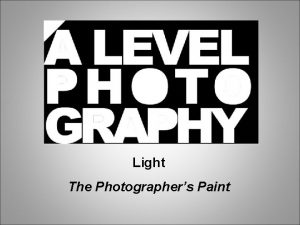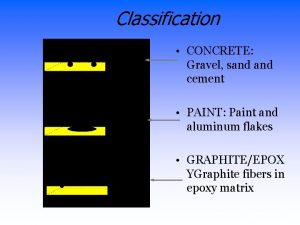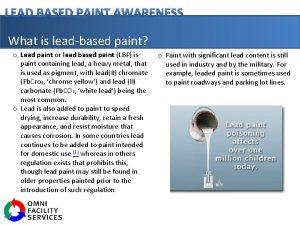Light The Photographers Paint Light is that part




































- Slides: 36

Light The Photographer’s Paint

Light is that part of the electromagnetic spectrum which is visible to the human eye. It is a type of wave energy, travelling at enormous speed (186 thousand miles per second!). Over millions of years the human eye has evolved so that it can detect the ‘visible’ part of the spectrum. Our brains perceive the different wavelengths of light as different colours. Some animals can see other types of electromagnetic radiation, for example snakes can also see infrared which is given off by hot objects, helping them to locate prey.

Artists long ago realised that to make a painting look realistic they needed to reproduce the way that light actually behaved. What is the direction of light in this painting by Raphael? (Where is the light coming from? ) Raphael, St Catherine of Alexandria, 1508

Direction of Light Raphael, St Catherine of Alexandria, 1508

Caravaggio, The Cardsharps, 1594 Caravaggio uses light to make this painting more three-dimensional and realistic. How does he use light to achieve this?

William Eggleston Lighting is one of the most important factors in creating a ‘good’ or successful photograph. Sam Taylor Wood

Chris Monaghan Lighting can help emphasise a mood or feeling.

Shadows indicate the direction of light and help make an image look more three-dimensional and realistic. Does this image look realistic?

What about now? How does adding a shadow make the image more three-dimensional?

Light has several different properties the visual artist: for 1. Quantity – how much light – bright, dim, faint etc. 2. Colour – the colour or ‘hue’ of the light? 3. Direction – where is the light coming from? 4. Quality – Is it a soft gentle light, or a harsh hard light giving crisp dark shadows.

1. Quantity of Light The amount of light that we get from a candle is clearly less than that produced by a bright torch or the sun on a bright day. The amount of light is measured by a light Meter. Most cameras have a built-in light meter so that the correct exposure can be given to the film or digital light sensor chip.

2. Colour of Light Our eyes and brain tend not to notice any change in the colour of daylight throughout the day. Surprisingly though, daylight is quite yellow/orange near dawn, and gets much bluer as midday approaches, finally becoming yellow/orange again as sunset approaches. Although we do not normally notice this change in what is often referred to as the colour temperature or colour balance of daylight, cameras do record the colour difference. Taken 11. 30 am (note blue tint) Taken near sunset (note yellow tint)

The Impressionists were probably the first painters who actually noticed that shadows are not just shades of black and grey! They painted shadows as they actually appeared. Note the blue tinted shadows in Monet’s The Stroll (colour of the woman’s white dress) and the green shadows in Sisley’s painting! Claude Monet, The Stroll, 1875 To detect the colour balance of daylight look at the colour of any shadow areas. Alfred Sisley, The Bridge, 1872

Warm colours (reds, oranges yellows & magentas) will give an image a different ‘feel’ to Cold colours (blues, cyan and greens). The colour balance of an image can be varied by: A) Placing a coloured filter over the camera lens. B) Adjusting the colour using software such as photoshop. What sort of colours have a ‘happy’ or ‘Lively’ feel? Which are colours might suggest calmness and tranquillity? C) Placing a coloured ‘Gel’ over any light being used to illuminate the subject. D) Altering the colour balance in a digital camera’s settings.

Nan Goldin The colour of the light source can signify not only the time of day, but also the mood or atmosphere. Anna Gaskell

This photograph was made using a small hand-held flashgun, fired 3 times during a long exposure at night. The flash was first fired through a red gel, then blue, then green, Gel = a coloured piece of transparent plastic used to change the colour of a light source.

3. Light Direction On planet earth the sun is normally above the eye-line. Because of this, light normally comes from above the subject. When the light direction is from below the subject it gives a very unnatural appearance, commonly known as Horror Lighting Film still from the Hammer horror film Dracula

4. Quality of Light ‘Soft’ Light Portrait of a Barrister by Angus Mc. Bean Using a soft but directional light source. Soft light produces gentle mid-tone shadows of low contrast

‘Hard’ Light Hard light produces crisp dark shadows with high contrast

Chris Monaghan These beach huts were photographed on a cloudy day – is the lighting soft or hard? This urban scene was photographed on a sunny day – is the lighting soft or hard? Chris Monaghan What do you also notice about the different way that colours are reproduced in soft and hard light?

Soft light gives low contrast and low colour saturation (the colours look a bit ‘flat’) Hard light gives high contrast and high colour saturation (the colours are more vivid)

One of the problems with very hard light (as on a very bright sunny day) is that the very high contrast can mean a loss of detail in the highlight or shadow areas. Note the way that some areas of this image have little or no information recorded in them (see the white highlight and black shadow areas have no detail recorded in them).

Many photographers favourite lighting for outdoor photography is found on a sunny day, but with some cloud present. Light on this type of day is quite hard (giving good colour saturation), but the clouds help prevent very high contrast which might stop detail being recorded in both highlight and shadow areas. Another advantage is that skies are thought by many to become more interesting when they include clouds. Chris Monaghan

Finding soft light on a very sunny day If you photograph in direct sunlight, the high contrast can cause problems in capturing detail in both highlight and shadow areas - some areas appear ‘burnt out’ or completely black. One solution to this problem is to find somewhere in the shade to photograph your subject. The light in shaded areas is usually much softer, although this will also mean lower contrast and colour saturation. Soft light in shadow areas Hard light in direct sunlight

Soft light in the studio is obtained by using a flash with a large Softbox Hard light in the studio is obtained using a flash with a small reflector

Hard & Soft Light & Surface Texture Soft Light Hard Light Soft light tends to flatten or hide surface texture, while hard light because of its more uni-directional character tends to emphasise surface texture.

The photographer Irving Penn wanted to show the lined textured face of the artist (Pablo Picasso). Penn therefore used a fairly hard light source. Irving Penn, Pablo Picasso

Female skin is generally thought to look more flattering without emphasising the texture (spots, lines, blemishes etc). The photographer here has used a large softbox to give flattering soft light. Soft light comes from large light sources and so hits the subject at many angles. This means that the light manages to get into all the little wrinkles and creases of the skin without causing shadows which would emphasise such skin blemishes. Chris Monaghan

Richard Avedon Lit with hard light – but actress Liz Taylor had excellent skin (and had good make-up on) so that few blemishes show. Nan Goldin Where might you find lighting with a green tint like this? How does this help us understand what is going on?

The directional lighting on these trees plays a vital role in this forest triptych (try to imagine what the images might look like if the lighting was soft and ‘flat’). Chris Monaghan

Shooting into the light can create interesting silhouette effects. Chris Monaghan

Photographer Philip Lorca di Corcia produced a series of images of unaware pedestrians as they walked along a busy sidewalk. He used a powerful flash so that the backgrounds became underexposed and dark.

Chris Monaghan Using flash outdoors allows the photographer to control the background exposure, in this case slightly under-exposing the background and helping to draw the viewer’s attention onto the main subject.

Gregory Crewdson creates elaborately staged film-like sets and lighting

Fashion photography Note the large white reflector to bounce light onto the shadow side of the model (the light is coming from behind and slightly to the right of the model). The tiny splashes of orange light formed by the setting sun help make this image just that little more special. By looking around, interesting natural lighting can often be found, as with this image of a Nun. Chris Monaghan

Summary Light is vital for the photographic process. To create better photographs we need to be aware and in control of the following: Quantity how much light – bright, dim, faint etc. Colour the colour or ‘hue’ of the light. Direction where is the light coming from. Quality Is it a soft gentle light, or a harsh hard light giving crisp dark shadows.
 Present perfect tense of play
Present perfect tense of play Abstract photography history
Abstract photography history Photographers who use typography
Photographers who use typography Tìm vết của mặt phẳng
Tìm vết của mặt phẳng Sau thất bại ở hồ điển triệt
Sau thất bại ở hồ điển triệt Thơ thất ngôn tứ tuyệt đường luật
Thơ thất ngôn tứ tuyệt đường luật Con hãy đưa tay khi thấy người vấp ngã
Con hãy đưa tay khi thấy người vấp ngã Thơ thất ngôn tứ tuyệt đường luật
Thơ thất ngôn tứ tuyệt đường luật Tôn thất thuyết là ai
Tôn thất thuyết là ai Phân độ lown
Phân độ lown Chiến lược kinh doanh quốc tế của walmart
Chiến lược kinh doanh quốc tế của walmart Gây tê cơ vuông thắt lưng
Gây tê cơ vuông thắt lưng Block xoang nhĩ là gì
Block xoang nhĩ là gì Paint part of speech
Paint part of speech Light light light chapter 22
Light light light chapter 22 Light light light chapter 23
Light light light chapter 23 Light light light chapter 22
Light light light chapter 22 Làm thế nào để 102-1=99
Làm thế nào để 102-1=99 Công thức tính độ biến thiên đông lượng
Công thức tính độ biến thiên đông lượng Tỉ lệ cơ thể trẻ em
Tỉ lệ cơ thể trẻ em Thiếu nhi thế giới liên hoan
Thiếu nhi thế giới liên hoan Fecboak
Fecboak Một số thể thơ truyền thống
Một số thể thơ truyền thống Môn thể thao bắt đầu bằng chữ f
Môn thể thao bắt đầu bằng chữ f Hình ảnh bộ gõ cơ thể búng tay
Hình ảnh bộ gõ cơ thể búng tay Hệ hô hấp
Hệ hô hấp Số.nguyên tố
Số.nguyên tố đặc điểm cơ thể của người tối cổ
đặc điểm cơ thể của người tối cổ độ dài liên kết
độ dài liên kết Trời xanh đây là của chúng ta thể thơ
Trời xanh đây là của chúng ta thể thơ Chó sói
Chó sói ưu thế lai là gì
ưu thế lai là gì Tư thế ngồi viết
Tư thế ngồi viết Thẻ vin
Thẻ vin Cái miệng nó xinh thế chỉ nói điều hay thôi
Cái miệng nó xinh thế chỉ nói điều hay thôi Thế nào là hệ số cao nhất
Thế nào là hệ số cao nhất Lp html
Lp html




























































